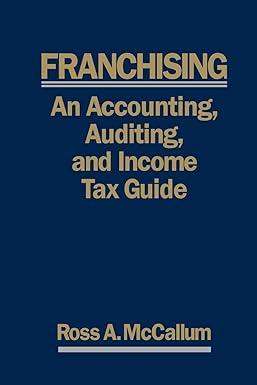Question
1. On December 31, 2016, Ashton Corporation performed forensic psychic consultation services for the Edamame Private Detective Agency. Ashton was short of cash, and Ashton
1. On December 31, 2016, Ashton Corporation performed forensic psychic consultation services for the Edamame Private Detective Agency. Ashton was short of cash, and Ashton agreed to accept a $200,000 note receivable due December 31, 2018, bearing interest at 8% payable semi-annually. The market rate for a note of similar risk is 6%.
What interest rate would you use to compute the cash interest payment?
What interest rate would you use to compute the present value of the note?
Calculate the present value of the note receivable:
Provide the journal entry for the issue of the note receivable:
2. The following are partial income statement account balances extracted from the December 31, 2017, year-end financials of Bio Industries interest revenue $45,000, restructuring costs $320,000, before tax loss on discontinued operations $400,000, loss on sale of investments $50,000. Income tax expense has not yet been recorded, and the income tax rate is 35%.
Prepare the lower portion of the 2017 income statement beginning with $800,000 income from continuing operations before income taxes. Include appropriate EPS disclosures. The company had 100,000 shares of common stock outstanding throughout the year. (Amounts to be deducted should be shown in (parentheses). Round EPS answers to 2 decimal places)
3. The trial balance of Watson International for Dec. 31, 2016, includes the following balances:
Debit Credit
Sales $600,000 (Credit)
Sales Returns Allowances $32,000 (Debit)
Accounts Recievable $140,000 (Debit)
Allowance for Doubtful Accts $4,700 (Credit)
If the estimate for uncollectibles is made by taking 2% of net sales, estimate bad debt expense and provide the journal entry to fund the Allowance for Bad Debts account.
If the estimate for uncollectibles is made by taking 11% of gross account receivables, estimate bad debt expense and provide the journal entry to fund the Allowance for Bad Debts account.
Provide the journal entry to write off $7200 in accounts receivables.
Suppose $2400 of the $7200 previously written off receivables ended up being paid. What journal entry (or entries) would you use to handle this transaction.
4. Go Tro uses a periodic inventory system. At the beginning of the January 2017, inventory consisted of 2,000 units costing $8 each. On January 10, 4,500 units were purchased costing $9 each. Finally, on January 20, 3,000 more units were purchased costing $10.50 each. Unit sales consisted of 1,000 units on January 8 for $20 each, 4,000 units on January 15 for $22 each, and 1,500 units for $24 each on January 25.
a. Calculate cost of goods sold, ending inventory, and gross profit under the FIFO method.
b. Calculate cost of goods sold, ending inventory, and gross profit under the LIFO method.
c. Calculate cost of goods sold, ending inventory, and gross profit under the weighted average method.
5. In December 2016, Bay Watch Company factored accounts receivable that had a book value of $500,000 to Spirit Bank, with recourse and estimates the fair value of the recourse obligation to be $10,000. Under the arrangement, Bay Watch transfers the $500,000 receivables to Klein, and Klein will remit 80% of the factored amount to Bay Watch in cash. Klein will retain the remaining 20% to cover its factoring fee (equal to 8% of the factored amount), and to provide a cushion against potential sales returns and allowances. After Klein has collected cash equal to the amount advanced to Bay Watch plus their factoring fee, Klein will remit the excess to Bay Watch. Under this arrangement, Klein provides Bay Watch with cash up-front and a beneficial interest in the transferred receivables equal to the fair value of the last 20% of the receivables to be collected (which management estimates to be $82,000) less the 8% factoring fee. Provide the journal entry for Bay Watch to record this transaction.
6. On January 1, 2017, Sang Company adopted the dollar-value LIFO method. The inventory value for its only inventory pool on this date is $600,000. Inventory data for 2017 to 2018 are as follows:
Date Ending Inventory at Year-End Cost Cost Index
12/31/17 $670,000 1.06
12/31/18 $750,000 1.14
Step by Step Solution
There are 3 Steps involved in it
Step: 1

Get Instant Access to Expert-Tailored Solutions
See step-by-step solutions with expert insights and AI powered tools for academic success
Step: 2

Step: 3

Ace Your Homework with AI
Get the answers you need in no time with our AI-driven, step-by-step assistance
Get Started


